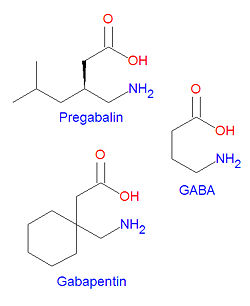Pregabalin: Difference between revisions
Jump to navigation
Jump to search

imported>David E. Volk (chemical info) |
imported>David E. Volk m (typo) |
||
| Line 2: | Line 2: | ||
[[Image:Pregabalin and related compounds.jpg|right|thumb|250px|{{#ifexist:Template:Pregabalin and related compounds.jpg/credit|{{Pregabalin and related compounds.jpg/credit}}<br/>|}}Pregabalin and gabapentin are structurally similar to GABA.]] | [[Image:Pregabalin and related compounds.jpg|right|thumb|250px|{{#ifexist:Template:Pregabalin and related compounds.jpg/credit|{{Pregabalin and related compounds.jpg/credit}}<br/>|}}Pregabalin and gabapentin are structurally similar to GABA.]] | ||
'''Pregabalin''' is structurally similar to [[gabapentin]]. | '''Pregabalin''' is structurally similar to [[gabapentin]]. It is also similar to the inhibitory neurotransmitter gamma-aminobutyric acid ([[GABA]]), and although it does not act on GABA receptors, it may increase the "density of GABA transporter protein and increases the rate of functional GABA transport".<ref name="DailyMed">{{DailyMed}}</ref> It is approved by the for neuropathic pain associated with [[diabetic neuropathy|diabetic peripheral neuropathy]], postherpetic neuralgia adjunctive therapy for adult patients with partial onset [[seizure]]s, and [[fibromyalgia]].<ref name="DailyMed">{{DailyMed}}</ref> | ||
== chemistry == | == chemistry == | ||
Revision as of 11:25, 29 February 2008
Pregabalin is structurally similar to gabapentin. It is also similar to the inhibitory neurotransmitter gamma-aminobutyric acid (GABA), and although it does not act on GABA receptors, it may increase the "density of GABA transporter protein and increases the rate of functional GABA transport".[1] It is approved by the for neuropathic pain associated with diabetic peripheral neuropathy, postherpetic neuralgia adjunctive therapy for adult patients with partial onset seizures, and fibromyalgia.[1]
chemistry
The IUPAC chemical name for pregabalin is (S)-(+)-3-(aminomethyl)-5-methylhexanoic acid. Its chemical formula is C8H17NO2 giving it a molecular mass of 159.23 g/mol. It is both an amine and a carboxylic acid.
References
- ↑ 1.0 1.1 Pregabalin - FDA approved drug information (drug label) from DailyMed (U.S. National Library of Medicine).
